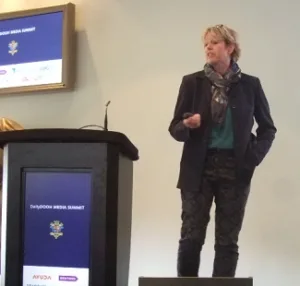The next speaker was Heather Andrew, CEO and founder of Neuro-Insight – a London-based company that examines the brain’s response to certain stimuli. The aim is to maximise the effectiveness of these stimuli within and across different media.
Ocean Outdoor commissioned Neuro-Insight to find how digital signage compares to other media. TV was the obvious and most similar comparison. TV acts as a ‘priming medium’ for other media; that is, an advert viewed on TV will heighten the response (make people more receptive) to linked adverts (i.e. adverts for the same product) on or in other media – by about 36%, according to the company’s research. Neuro-Insight wanted to find out if digital signage could play a similar role.
Going into the research, Neuro-Insight knew three key points:
- Iconic OOH installations act as a priming medium. Viewing a message on a high-profile site will heighten the emotional response to a linked campaign on a ‘standard’ OOH site.
- Full-motion sites have a larger impact than static ones.
- The same media primes itself, i.e. OOH for OOH.
The hypothesis being tested was, ‘DOOH’s ability to prime goes beyond OOH and can extend into the wider media landscape’. Neuro-Insight measured peoples’ memory encoding, but not directly to signage. Clear Channel asked the company to test responses to secondary non-signage media, after people were exposed to premium DOOH sites.
192 respondents were used and were split into a group being exposed to a signage advert and a group being exposed to a TV advert, which was used for control. Two adverts were used, one for Lynx and one for Peugeot; half of each group saw an advert for Lynx, and the other half of each group saw the advert for Peugeot.
The people in the study were not told beforehand what was being tested, so they were walked past one of the signage sites (either ‘Eat Street @ Westfield’ or ‘The Screen @ New Street’) without specifically being told to look at it. The TV group were told that they had arrived early for the study and were seated in a room with a TV, which switched to an advert break showing an ad for one of the two brands. Andrews admitted that this may have biased the study slightly, as more attention would have been focused on the TV than the DOOH site.
While going through the study, everyone was exposed to both Lynx and Peugeot adverts. First they browsed magazines in which these adverts featured, and next used iPads. The tablets were used for general web browsing; the people were then directed to specific websites with adverts for the brands, and then to the brands’ own websites.
The results showed that the medium itself can have a priming effect, regardless of content. People who had been ‘primed’ by watching TV had a response to unmatched campaigns (i.e. Peugeot campaigns if they have been in the Lynx group) in magazines that was 11% higher than those in the DOOH group. However, people primed by DOOH had a response that was 36% higher to unmatched campaigns on the tablets.
Andrews called this ‘the congruence effect’, which plays out in similar media. TVs and magazines are similar in that both are lean-back, relaxed experiences. Digital signage and mobile are similar in that both are about enhanced responses to communication on-the-go.
Another finding was that linked advertising amplifies the priming. People primed by TV had a 27% higher response to the matched campaign than the unmatched campaign, while the response of those primed by DOOH was 48% higher!
An audience member asked what the third stage of research would be (the first stage was finding the the three key points that were known beforehand, and this study was the second stage). Andrews said that they could look into a changing advert, which is known to have a ‘ratcheting’ effect. For instance, driving past the same advert for three days and then changing it on the fourth day.
Other questioners asked what the effect would be with static posters (largely similar, but less pronounced) and how close we are to using neuroscience in the field (not very).

